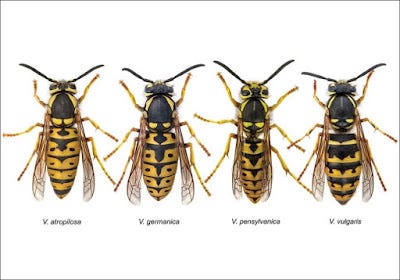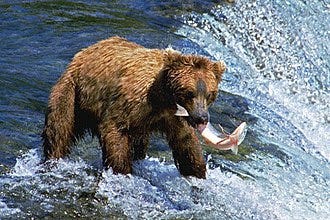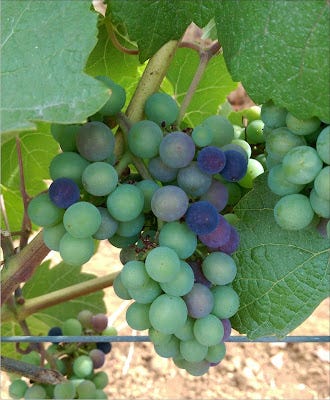Amalie Robert Estate Vintage Update: 2018 Pinot Noir In Flagrante!
Hello and Welcome,
This is a 2018 Vintage Update from Amalie Robert Estate. A FLOG communication.
We have spied the first blazing Pinot Noir berry on Friday, August 3rd- Julien calendar day 215. And it was the cutest thing, ever! All nestled in among the rest of the green berries, our harbinger of the vintage was all aglow.

Why yes, in fact, it was a Wadenswil clone Pinot Noir wine berry. We just love that clone, especially when grafted onto the legendary 5C rootstock. 5C may be slower to mature than those less endowed, shallow rooted rootstocks, but that means longer hang time, more aroma and flavor development and less alcohol potential. Who could ask for anything more?
And now that we have seen that blazing berry, it is time to bait the yellowjacket traps! And let us introduce the little Vespula blighters in their full regalia. And to set the record straight, these are classified as wasps, not hornets. Hornets are a whole other mess of trouble best handled with a flamethrower from a safe distance in suitable protective clothing. That funny guy from Tesla makes one…

If you happen to be stung by one of these Vespula, take a few microseconds to notice the thorax coloring scheme. It could be the sting is not so bad from Vespula atropilosa or Vespula pensylvanica. But if Herr Vespula germanica or Vespula vulgaris tags you, well there is gonna be some extended whoopin’ and a hollerin’ we can tell you that for sure, for sure good buddy!
Now these little wasps pack a punch, but a little research can pay healthy dividends. First off, these insects are ground dwellers. They nest under shrubs and bushes. Their most favorite shrubbery happens to be the ubiquitous blackberry. Not just any blackberry mind you, but the Himalayan or Armenian blackberry - Rubus armeniacus.
The native, and most preferred, culinary blackberry species in the Great Pacific Northwest is the Rubus ursinus. Commonly known as the Pacific Blackberry. Clearly the taxonomy folks were taking a little artistic license from the bears of the Great Pacific Northwest when classifying this plant. So be it – never let the truth get in the way of a good story. Vespula horribilis anyone?

The reason our little Vespula prefers the Rubus from Armenia is that they grow along the ground in a prostrate manner. They cover a tremendous amount of area with large thorny leaves and shoots that deter predators and provide them safe haven. The first, best predator of the Vespula is the common skunk. The risk, apparently, is worth the reward and we give these monochromatic wasp hunters a wide berth.
Right, now we know where they live. The eradication of the Vespula is virtually impossible and while a worthy goal, it is the equivalent of trying to boil the ocean. We are just trying to make wine. So one day, there was some clever fellow who devised a totally tubular yellowjacket trap. Bravo!

What we see depicted here is successful communication. The trap has been baited with a strong yellowjacket aphrodisiac. The yellowjackets are picking up on what’s going down and they want in on the action. All is right with the world. But wait, there is more. Enter the wild Oregon caught Chinook salmon.
You see these traps come from the factory with a synthetic attractant. And while most of the Vespula are good with that Herr Vespula germanica is having none of it. And it just so happens we know his weakness, it is freshly ripened wild Oregon caught Chinook salmon.
Our local fish monger knows when the first Pinot Noir wine berries start to turn color because that is when we show up at his door looking for fresh wild Oregon caught Chinook salmon scraps to trap our little Vespula. Of course, we take a fillet as well to have with Pinot Noir – for quality control purposes, of course.
Alright, let’s bring it home. We start out with about 20 of these totally tubular Vespula condos and start packing them full of salmon scraps. This is best done about an hour before daylight in a Vespula proof enclosure. Then we have specially modified coat hangers that fit through the molded hole at the top of the trap (those guys thought of everything.) Then, just as first light is being cast onto the vineyard we hang the traps on our south facing steel end posts very near the Rubus from Armenia.
It takes a while for the first early adopters to arrive. They buzz around investigating this new addition to their environment. Then around noon time, the sun has warmed up that steel end post and the wild Oregon caught Chinook salmon scraps inside the trap start to “ripen.”
Then look out! Herr Vespula germanica has picked up the scent and he is coming in hot! From this point forward, it is just a matter of hours before the trap is full and we must reload.
While it is quite heartwarming to see these traps fill up so quickly, this in fact is one of the necessary harvest pre-functions. Once all the blackberries are gone, there is only one fruit left to eat and that is the wine berry. The Vespula will attack the wine berry which has done nothing wrong, just ripen in the sun. They will eat all of the pulp inside and leave a hollowed-out skin. They like the sweet, but can’t seem to handle the skin tannin.

The problem arises when the harvest humans start to interact with the Vespula environment while the Vespula is consuming said wine berry. The problem is exacerbated when several Vespula, under the direction of Herr Vespula germanica, are feasting on adjacent clusters. You can hear the distinctive whoopin’ and a hollerin’ from quite a ways off.
So, we have about 45 days of ideal weather to “harvest” as many of these Vespula as we can so that they are not around during harvest operations. The other way to go about this is to use a can of aerosol hair spray and a lighter - mini flamethrower if you will. But as Ernie would remind you, experience is what you get when you don’t get what you want. So we have moved on to the wild Oregon caught Chinook salmon scraps.
We are still predicting a late September to early October start to harvest, but in the agrarian world, anything can happen between now and then - and most likely will. Are we going to get some rain? Oh, we hope so!
Now if you just can’t wait, you can check in on the spaghetti harvest here. While they do not have to contend with the dreaded Vespula, they do have the spaghetti weevil, and Vespas. Watch out!

https://www.youtube.com/watch?v=tVo_wkxH9dU
Kindest Regards,
Dena & Ernie



